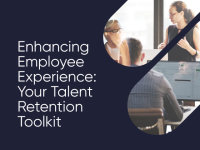CallMiner Product Innovation Series: Q1 2025
CallMiner's, Bruce McMahon, shares key product updates from Q1 2025. CallMiner AI Assist advancements, CallMiner Outreach, Bulk Export API enhancement...
CallMiner Outreach is here! |Learn about the future of CX

Solutions
Products
Customers
Solutions
Products
Customers
Resources
Company
The Team at CallMiner
December 13, 2019


Updated May 31, 2022
Most business invest time, effort and scrutiny on the customer experience. However, its internal equivalent – the employee experience – receives far less attention than it deserves in many organizations.
Although employees are not typically direct consumers of their company’s products and services, they affect its bottom line as creators of its offerings and market value. Understanding what your organization’s employees are thinking and feeling when it comes to their roles and time spent on the job can prove invaluable in the improvement of all your operations.
To make a positive impact on your employees’ collective experience at your company, it is important to fully grasp the meaning of this term and its ramifications.

The employee experience is the totality of an individual’s feelings and observations throughout their time at a given company.
The daily realities of every employee combine to form their overall experience with your organization, and this very experience can color their actions for the duration of their employment.
An employee’s experience with your company has the power to transform their actions while on the job. The best work ethic can quickly become tainted by a lack of enthusiasm for working at a job where aspects such as mutual respect and proper communication run in short supply.
Likewise, less-than-enthusiastic employees can be won over by an overwhelmingly positive experience at work that trickles into their output in their roles. In fact, it is the improvement of employee engagement that underpins the overall effort of improving the employee experience.
Employee Engagement
An employee’s engagement on the job boils down to their commitment to their responsibilities and the far-reaching objectives of the company. Individuals going out of their way to do their best and give their all while on the clock can help any organization go from ordinary to extraordinary. They are far less likely to do so when their own experience is significantly less than optimal.
Improving the experience that your company offers its employees is a multifaceted task with no single perfect approach. Instead, there are numerous opportunities for improvement that depend entirely on your company’s values and structure. Following are a few best practices for cultivating an ideal employee experience within your organization:
The landscape of interpersonal relations within your organization helps to determine the degree to which employees feel satisfied in their positions. However, this landscape traverses three entirely distinct dimensions that must be optimized individually. They are as follows:
The technological dimension of your business’s internal structure centers on the devices and tools you place at each employee’s disposal.
Tools used on the job range from client-facing communication programs to the chairs and desks your workforce uses. The technology each hire utilizes to get his/her job done is a constant in their daily work life. As such, investments in the most effective and comfortable toolkits can pay off tremendously in improving the employee experience.
Your workforce’s physical environment – the building and location to which they commute daily – is a clear factor at play in influencing your staff’s perceptions. Thus, it is worth improving to positively impact the employee experience.
An accessible location that is clean and well-maintained is always a plus for the people who are expected to work there.
Your company’s cultural structure boils down to factors such as compensation, hierarchies, and the overall feel of your workplace.
An inviting, yet disciplined cultural environment is far more likely to nurture the best results from your employees than an unruly and unmoderated workspace fraught with unclear management.
Your business’s employee experience manager focuses on fostering a more beneficial and generally positive work environment by factoring in both the financial and emotional needs of your employees. Ensuring everyone feels their contribution is valued and appreciated comes into play for EEM’s, as does making sure work/life balance concerns are fully accommodated.
Empowering your EEM’s comes down to providing them with the necessary high-level insights they need to make impactful decisions as well as giving them the flexibility to implement novel strategies and ideas.
Surveys of all types can be administered to your workforce as a means of determining their common concerns long before problems surrounding these arise.
Perhaps more importantly, the simple habit of having regular employee surveys for your staff to fill out helps to show that you are indeed listening to their concerns and have a vested interest in their wellbeing at work.
An employee’s journey is the collection of experiences they have from the moment they are hired (or even shortly before) to the moment they choose to leave your company (or sometime after this).
Delineating the milestones that each employee encounters along the way can provide highly valuable insight into your company’s pressure points, allowing you to improve in the ways that matter most to your workforce.
How has your organization cultivated a better employee experience?
CallMiner is the global leader in conversation intelligence to improve customer experience (CX). CallMiner delivers the industry’s most comprehensive platform to analyze omnichannel customer interactions at scale, combining deep domain expertise with cutting edge AI analytics and machine learning. By elevating insights from the contact center to the boardroom, CallMiner enables companies to identify areas of opportunity to drive business improvement, growth and transformational change more effectively than ever before. CallMiner is trusted by the world’s leading organizations across all major verticals including technology, media and telecom (TMT), retail, manufacturing, financial services, healthcare, and travel and hospitality.